Stargazing has always been a wonderful hobby, and some of the most captivating sights in the night sky are the planets of our solar system. Whether you are a curious beginner or an avid astronomer, choosing the right telescope to see planets can elevate your observations to awe-inspiring heights. In this article, we will explore the best telescopes that provide crystal-clear views of the planets allowing you to embark on an unforgettable celestial journey. We will help best telescope for viewing planets Unlock the Secrets of the Planets with our guide to Planetary telescopes!

Why Buy a Planetary Viewing Telescope?
There are many telescope designs and there is no telescope that does everything best. Each telescope offers a unique stargazing experience, so it is important to choose the one that best aligns with your interests, requirements and expertise. The best telescope for viewing planets features higher magnification and larger aperture for higher light-gathering power. We will help you to choose the best telescope to see planets. Experience the Beauty of the Moon, Venus, Mars, Jupiter, Saturn, and Beyond with the Best Telescopes for Planetary Viewing!
What Makes a Planetary Telescope Different from a Deep Space Telescope?
The planets appear as relatively small disks and a telescope with a long focal length for higher magnifications works best, while a telescope for viewing deep sky objects (galaxies, nebulae, star clusters, the Milky Way etc) generally needs wide field of view as such objects are often bigger in the sky and require lower magnifications to see them best. Best telescopes for planets offer a good focal length to let you use higher magnification and view more of the details of the planets through the eyepiece.
Planet Viewing Telescope Buying Guide
It is crucial to choose the right telescope for your planetary astronomy. The best telescope for you to see planets will have the following main features:
Good Quality Optics: Improved Image Quality
It goes without saying, but the telescope’s optical quality is critical to getting good images. Stick to the major brands and seek advice from us if you have questions.
Large Aperture: The Key to Crystal-Clear Views
A crucial factor in a telescope for planets is its aperture, - the optical diameter - which determines the amount of light the telescope can gather. Larger apertures result in brighter and more detailed views of planets. For the best planetary observations, consider telescopes with at least a 4-inch (100mm) aperture or larger. A telescope of this size will reveal intricate details, such as the cloud bands on Jupiter or the stunning rings of Saturn. And the bigger the telescope, the more you can see!
A Good Range of Magnifications
Magnification (Power) is determined by the eyepiece used in the rear of the telescope. This is the part that you actually look through. Different eyepieces will give different magnifications. Optimum magnification for viewing the planets is often in the 100x-200x range, when observing conditions are good higher magnifications can be used, up to around 2x per mm of aperture/ 50x per inch of aperture – so a 100mm (4”) telescope will handle up to 200x magnification.
Sharper views will generally be had at magnifications lower than the maximum though, as the earth’s atmosphere will degrade the image especially when the object in question (planet in this case) is lower in the sky. This is why it is important to have a sensible range of accessories and a choice of magnifications.
Mount Stability: Steady and Smooth Tracking
A stable mount & tripod is essential for smooth tracking of planets across the night sky. There are two main types of mounts: equatorial and alt-azimuth. Equatorial mounts track the sky in an arc and are ideal for following the planets' precise paths, while alt-azimuth mounts, although simpler in operation – moving left-right and up-down, can make it harder to follow objects across the sky.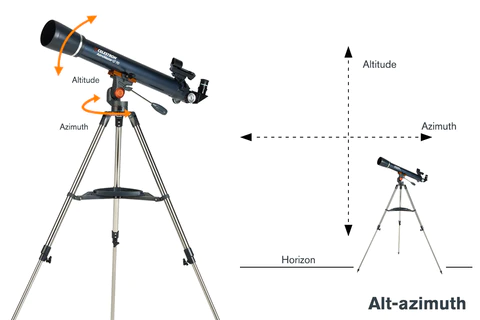
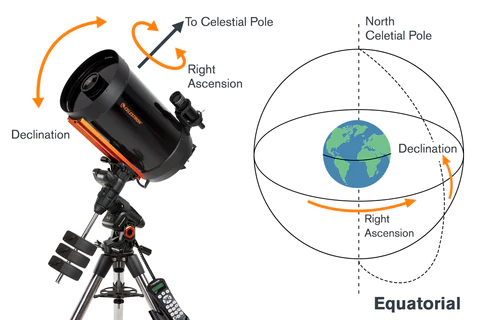
For beginners, alt-azimuth mounts often provide a more user-friendly experience, whereas equatorial mounts can actually teach you more about the way the sky works. Whichever Mount you choose for your Planetary Telescope make sure it is a stable one to give you the best views if the Moon and planets.
Manual mounts vs. Go-To Functionality and Smart Technology
Many telescopes are equipped with Go-To or Smart Technology using computerized systems to automatically locate and track celestial objects, including planets. Depending very much on the individual, this technology can simplify planet finding, especially for newcomers to astronomy. Once mastered, with just a few clicks, the telescope will align itself and point you directly to your desired object, making your stargazing experience enjoyable and hassle-free.
But – there was a 400 year gap between the invention of the telescope and the invention of modern computing, and during these 4 centuries people had a lot of fun with telescopes viewing planets and galaxies and made a lot of discoveries. You do not need a computerised telescope to enjoy the night sky and the planets! Many beginners – and seasoned observers – prefer to just get out there and look, and learn the astronomy and the night sky as you go along. Manual telescopes are a joy to use too!
Portable Design: Explore the Skies Anywhere
Consider how portable you need your planetary telescope to be. Do you have a good location to use it, like a garden or a local park? If you plan to take your telescope to various locations for stargazing, a compact and lightweight telescope is essential. A portable telescope will allow you to explore different vistas, and you'll never miss an opportunity to witness the planets' beauty wherever you go.
Astrophotography Capabilities: Capture Planet Beauty
If you have an interest in astrophotography you can start with a Smartphone adapter such as Celestron’s NeXYZ, or you can connect your existing DSLR camera body with a T-Ring Adapter (we can advise you on this). Your smartphone can take great pictures – especially of the Moon and (with practice) the planets, and will allow you to easily share your experiences. A DSLR may provide a higher resolution image. A mount that tracks the sky as the Earth rotates is pretty much a prerequisite for astronomical photography.
Types of Telescopes Available:
There are three main Telescope types:
Refractor Telescopes
Refractor Telescopes employ a lens system to gather and focus light. The primary lens at the front of the telescope bends and refracts incoming light, directing it to a focal point where the eyepiece is located. These telescopes can have outstanding optics ideal for viewing planets, and benefit from robustness, durability and low maintenance. They can excel in astrophotography, give exceptional high contrast views of Moon and planets and ease of use is a main virtue. Upright images also make the refractor a good telescope for distant terrestrial viewing.

Reflector Telescopes
Reflecting Telescopes use mirrors to gather and focus the incoming light. ‘Newtonians’ are cheaper to produce than similar aperture refractors and do have many advantages. The world’s largest observatories (On the ground and in space) use reflecting telescopes and they can make great amateur telescopes for planets. The eyepiece you look through is on the side of the tube, near the top, so they are usually on shorter tripods or floor-mounted stands. ‘Dobsonian’ telescopes are Newtonian reflectors on a simple alt-azimuth (az) mount.
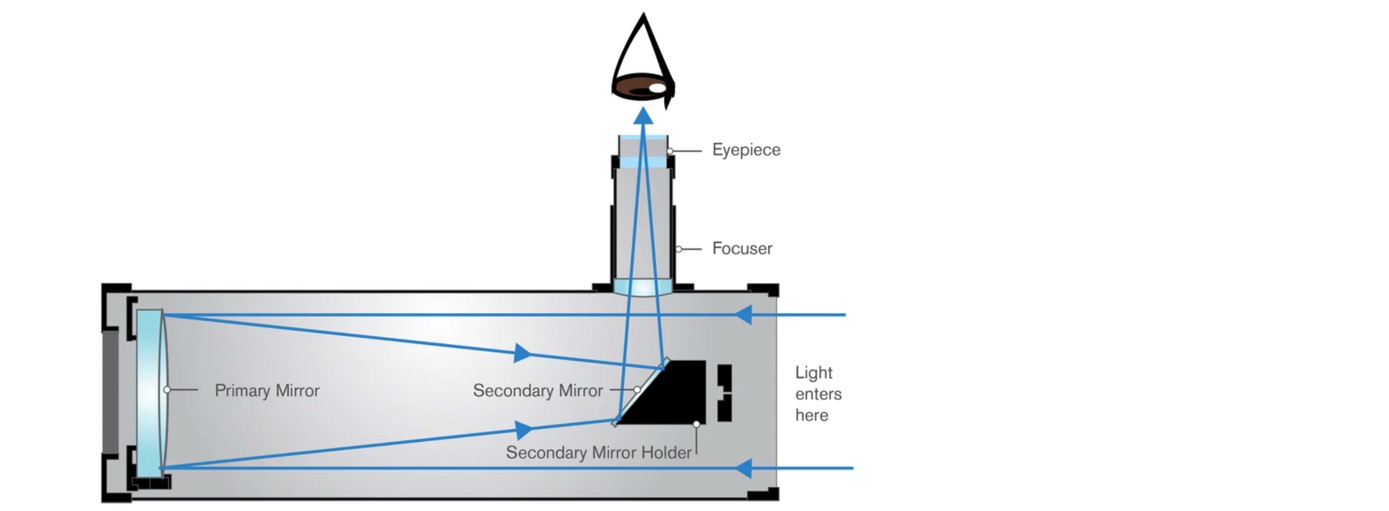
Cassegrain Reflectors
There are several types of Cassegrain Telescopes coming under the general heading of ‘catadioptic’ telescopes, generally using both lenses and mirrors to produce the image. The names ‘Maksutov-Cassegrain’ and ‘Schmidt-Cassegrain’ come up a lot and are the two main types. Like refractors, these are of a long focal length, making them great telescopes for viewing Moon and planets, but as the optical design is folded optically in a short tube, they are easier to handle, easier to mount, store and transport. The Cassegrain designs are compact, portable and relatively maintenance free.

10 Best Telescopes for viewing Planets
In this section we will introduce a selection of planetary telescopes. We have carefully selected these based on over 50 years’ experience and feedback from our happy customers. We will be happy to help to choose the best telescope for viewing planets for you!
Celestron StarSense Explorer 80AZ Telescope
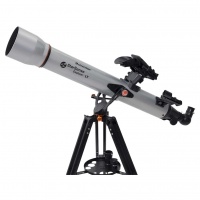 Sir Patrick Moore always recommended a 3” refractor as the best first telescope for astronomy, and this 3.1” offering from Celestron will not disappoint, benefitting from modern optical design and optical coatings, for sharp, high contrast images, and Celestron’s stunning ‘StarSense’ technology which basically commandeers the camera on your smartphone (which you place in a bracket on the telescope) and then gives you directions to any object in the sky. No tracking or ‘GoTo’ function just sheer fun and enjoyment.
Sir Patrick Moore always recommended a 3” refractor as the best first telescope for astronomy, and this 3.1” offering from Celestron will not disappoint, benefitting from modern optical design and optical coatings, for sharp, high contrast images, and Celestron’s stunning ‘StarSense’ technology which basically commandeers the camera on your smartphone (which you place in a bracket on the telescope) and then gives you directions to any object in the sky. No tracking or ‘GoTo’ function just sheer fun and enjoyment.
Sky-Watcher Heritage 100P Tabletop Telescope
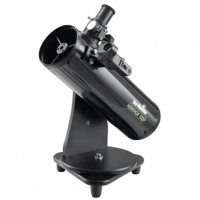 An exceptionally popular choice, which also works well as a gift thanks to its compact size and colourful packaging, this 4” tabletop reflecting telescope will give stunning views of the Moon and show disks of the major planets and the rings of Saturn and also has enough light gathering for the observation of star clusters, bright galaxies and nebulae. With ‘grab and go’ simplicity and portability, this is a telescope which will get used very often.
An exceptionally popular choice, which also works well as a gift thanks to its compact size and colourful packaging, this 4” tabletop reflecting telescope will give stunning views of the Moon and show disks of the major planets and the rings of Saturn and also has enough light gathering for the observation of star clusters, bright galaxies and nebulae. With ‘grab and go’ simplicity and portability, this is a telescope which will get used very often.
Sky-Watcher Skymax 127 AZ-GTi Telescope
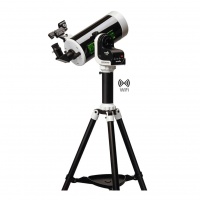 A best seller, the latest iteration of Sky-Watcher’s fabulous 5” Maksutov-Cassegrain telescope comes with a highly portable, Wifi controlled mount and out of the box it has magnifications up to 150x. With true airline portability, this a great choice for the astronomer on the move, and is an exceptional performer on Moon and planets. Sky-Watcher’s free SynScan App allows you to control the telescope with your smartphone or tablet.
A best seller, the latest iteration of Sky-Watcher’s fabulous 5” Maksutov-Cassegrain telescope comes with a highly portable, Wifi controlled mount and out of the box it has magnifications up to 150x. With true airline portability, this a great choice for the astronomer on the move, and is an exceptional performer on Moon and planets. Sky-Watcher’s free SynScan App allows you to control the telescope with your smartphone or tablet.
Celestron Astromaster 130EQ Telescope with camera adapter
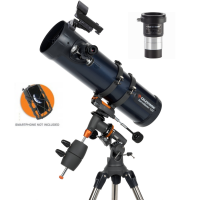 With its 130mm (5.1”) optics, this excellent equatorially-mounted reflecting telescope from Celestron is a superb all-rounder and comes with a basic smartphone bracket in the box. This model can be easily upgraded to track the sky with a motor drive kit, allowing easier viewing at high magnifications and the chance to take some great planetary photographs. Its larger aperture allows for the observation of star clusters, bright galaxies and nebulae.
With its 130mm (5.1”) optics, this excellent equatorially-mounted reflecting telescope from Celestron is a superb all-rounder and comes with a basic smartphone bracket in the box. This model can be easily upgraded to track the sky with a motor drive kit, allowing easier viewing at high magnifications and the chance to take some great planetary photographs. Its larger aperture allows for the observation of star clusters, bright galaxies and nebulae.
Celestron Nexstar 6SE Telescope
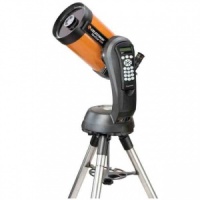 This 6” aperture Schmidt-Cassegrain telescope on a computerised alt-azimuth mount is surprisingly compact and very versatile and makes an excellent first telescope. The computerised handset has an on-board database of over 40,000 objects including Moon and planets. Alignment is simple thanks to Celestron's SkyAlign technology. Upgrades easily to Wifi control and also allows easy camera connections for astrophotography.
This 6” aperture Schmidt-Cassegrain telescope on a computerised alt-azimuth mount is surprisingly compact and very versatile and makes an excellent first telescope. The computerised handset has an on-board database of over 40,000 objects including Moon and planets. Alignment is simple thanks to Celestron's SkyAlign technology. Upgrades easily to Wifi control and also allows easy camera connections for astrophotography.
Sky-Watcher Skyliner 200P Telescope
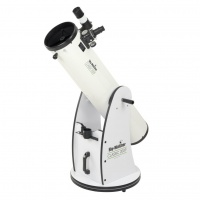 One of the true bargains in the telescope world. Stunningly good optics, and a very simple but smooth and stable Dobsonian Alt-Azimuth mount. This full 8” aperture reflector will show a wealth of fine detail on the planets including multiple cloud belts and The Great Red Spot on Jupiter and the Rings and many fainter satellites of Saturn, . Point and shoot simplicity combined with a significant aperture makes this a superb telescope for exploring Moon and planets.
One of the true bargains in the telescope world. Stunningly good optics, and a very simple but smooth and stable Dobsonian Alt-Azimuth mount. This full 8” aperture reflector will show a wealth of fine detail on the planets including multiple cloud belts and The Great Red Spot on Jupiter and the Rings and many fainter satellites of Saturn, . Point and shoot simplicity combined with a significant aperture makes this a superb telescope for exploring Moon and planets.
Celestron Advanced VX 8” SCT Telescope
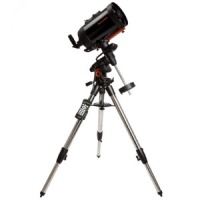 Possibly the closest thing to an ‘all-rounder’ telescope that does a bit of everything – with many options to progress further into the hobby in one or more of many directions. A full 8” aperture, compact tube size, very stable equatorial mount with tracking and Goto. Celestron StarBright XLT coatings for maximum light transmission. Long focal length for image scale on the Moon and planets make it an ideal setup that is ready for both imaging and visual observing.
Possibly the closest thing to an ‘all-rounder’ telescope that does a bit of everything – with many options to progress further into the hobby in one or more of many directions. A full 8” aperture, compact tube size, very stable equatorial mount with tracking and Goto. Celestron StarBright XLT coatings for maximum light transmission. Long focal length for image scale on the Moon and planets make it an ideal setup that is ready for both imaging and visual observing.
Celestron Nexstar Evolution 9.25” Telescope
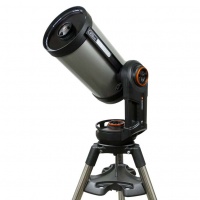 Another Celestron innovation, the excellent ‘Evolution’ range not only have a fully computerised Goto mount but have built-in Wifi and an internal rechargeable lithium battery to keep you planet-hunting all night. The largest aperture and longest focal length of the range, the 9.25” optimised for image contrast and is an outstanding telescope for observing and photographing the Moon and planets. Celestron's free SkyPortal app allows easy control of your telescope and makes navigating the night sky fun and intuitive.
Another Celestron innovation, the excellent ‘Evolution’ range not only have a fully computerised Goto mount but have built-in Wifi and an internal rechargeable lithium battery to keep you planet-hunting all night. The largest aperture and longest focal length of the range, the 9.25” optimised for image contrast and is an outstanding telescope for observing and photographing the Moon and planets. Celestron's free SkyPortal app allows easy control of your telescope and makes navigating the night sky fun and intuitive.
Celestron StarSense Explorer 10” Dobsonian Telescope
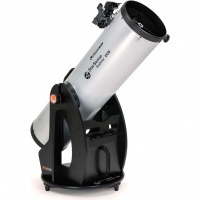 A larger aperture again, this 10” telescope gives a fantastic experience when observing Moon and planets, showing an abundance of surface detail, faint satellites, and bright, vivid images. An ergonomically designed AltAz Mount makes this telescope easy to set up and highly transportable. This model uses Celestron’s highly innovative StarSense Explorer technology to use your smartphone or tablet to guide the telescope around the night sky, taking you to Moon and planets with ease.
A larger aperture again, this 10” telescope gives a fantastic experience when observing Moon and planets, showing an abundance of surface detail, faint satellites, and bright, vivid images. An ergonomically designed AltAz Mount makes this telescope easy to set up and highly transportable. This model uses Celestron’s highly innovative StarSense Explorer technology to use your smartphone or tablet to guide the telescope around the night sky, taking you to Moon and planets with ease.
Sky-Watcher Skyliner 300P Flextube Dobsonian Telescope
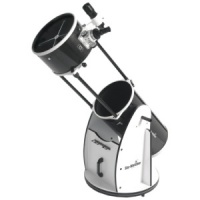 An even bigger aperture! A 12” mirror in a telescope will show vast amounts of detail on Moon and planets and provide a lifetime of pleasure. This telescope offers an incredible aperture-to-price ratio. The innovative ‘Flextube’ design allows for more compact storage and easier transportation, and the manual Dobsonian mount is simplicity itself. This telescope is also available as a fully computerised ‘Goto’ version. A wealth of subtle details on the Moon and Planets and objects further afield will be at your disposal. The Universe is waiting!
An even bigger aperture! A 12” mirror in a telescope will show vast amounts of detail on Moon and planets and provide a lifetime of pleasure. This telescope offers an incredible aperture-to-price ratio. The innovative ‘Flextube’ design allows for more compact storage and easier transportation, and the manual Dobsonian mount is simplicity itself. This telescope is also available as a fully computerised ‘Goto’ version. A wealth of subtle details on the Moon and Planets and objects further afield will be at your disposal. The Universe is waiting!
Must have Accessories for viewing Planets
Eyepieces
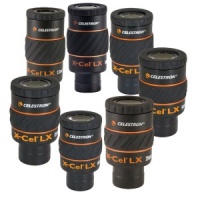 Eyepieces are essential components of a telescope that determine the magnification and field of view. When it comes to observing planets, having a range of eyepieces at your disposal allows you to adapt your telescope's performance to suit different planetary details and atmospheric conditions. By selecting the ideal eyepiece, you can unlock hidden features and appreciate the unique characteristics of each planet.
Eyepieces are essential components of a telescope that determine the magnification and field of view. When it comes to observing planets, having a range of eyepieces at your disposal allows you to adapt your telescope's performance to suit different planetary details and atmospheric conditions. By selecting the ideal eyepiece, you can unlock hidden features and appreciate the unique characteristics of each planet.
Popular eyepiece options for planet viewing include:
- High-Magnification Eyepieces: For observing fine details on planets like Mars and Jupiter's cloud bands.
- Medium-Magnification Eyepieces: For observing Venus and Mercury as they pass through phases, and the satellite systems of Jupiter & Saturn.
- Wide-Angle Eyepieces: For dramatic ‘porthole’ like views of the Moon, and for conjunctions of the Moon and planets when they sometimes appear close together in the sky.
Finderscope
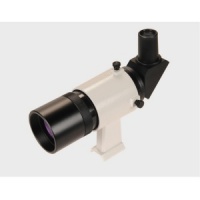 A finderscope is a small, secondary telescope or sighting device mounted on a larger main telescope. Its primary purpose is to aid in locating celestial objects in the night sky, making the process of star-hopping and target acquisition significantly easier. Finderscopes have a wide field of view, helping you pinpoint objects quickly and accurately. These can have lenses and magnify the image, and usually have a crosshair in the centre of the field of view, like a rifle sight, or are 1x magnification and superimpose a red dot on the sky (commonly referred to as a ‘Red Dot Finder’). Each type (Optical Finder or Red Dot Finder) has its own advantages but just having one is the important thing.
A finderscope is a small, secondary telescope or sighting device mounted on a larger main telescope. Its primary purpose is to aid in locating celestial objects in the night sky, making the process of star-hopping and target acquisition significantly easier. Finderscopes have a wide field of view, helping you pinpoint objects quickly and accurately. These can have lenses and magnify the image, and usually have a crosshair in the centre of the field of view, like a rifle sight, or are 1x magnification and superimpose a red dot on the sky (commonly referred to as a ‘Red Dot Finder’). Each type (Optical Finder or Red Dot Finder) has its own advantages but just having one is the important thing.
Planetary Filters
Filters for visual exploration of the Moon and planets are very useful and a worthwhile addition to an Astronomer’s tool box. Such filters fit to the telescope’s eyepieces and provide higher contrast views than you can get without a filter in place. The Moon is so bright that a Moon filter or variable polariser filter will remove the glare and enhance the detail. Different coloured filters will increase the contrast between different details. For example, a yellow filter will not only increase surface detail visibility on the Moon, but enhance the view of cloud belts on Jupiter and Saturn. Red and green filters will enhance the dark surface markings on Mars, or highlight the polar caps respectively. A blue filter will again enhance different cloud belts on Jupiter and Saturn.
Many specialist filters are available, to reduce light pollution, to enhance the performance of different telescope types, and performance on different types of objects, for both visual and photographic use. We recommend starting out with a filter for the Moon, and adding a basic planetary filter set to your eyepiece case.
Conclusion
The universe is a vast and wondrous place, and observing the planets of our solar system can be an awe-inspiring experience. The telescopes mentioned in this article have proven themselves as some of the best tools for exploring and appreciating the beauty of our neighbouring worlds.
Whether you are a seasoned astronomer or just beginning your celestial journey, investing in the right best telescope for viewing planets will undoubtedly enhance your planetary viewing adventures. Remember to consider your observing preferences, budget, and level of expertise when selecting the best telescope to see planets. With one of these exceptional telescopes by your side, you can unlock the wonders of the cosmos and embark on an extraordinary voyage through the celestial realms. Happy stargazing!
Do you need more help in choosing the best telescope for viewing planets for you? Then call us on 01353776199 or email sales@widescreen-centre.co.uk for more advice. We are happy to help!
Clear skies!
Simon, Elena and The Widescreen Centre Team

